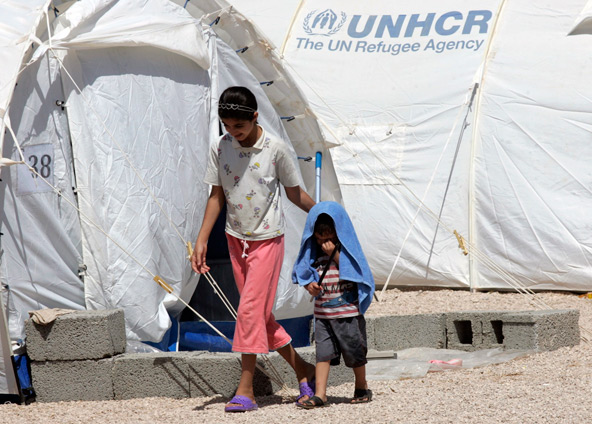
WASHINGTON (CNS) — While media images of the Syrian civil war are mainly those of men with guns, workers from Catholic Relief Services have seen “predominantly women and children, fleeing,” said a communications officer who recently returned from the Middle East.
Syrian women, hailing from a society that gives them little chance to make their voices heard, were “tugging on my sleeve, begging me to tell their stories” in the United States, said the manager, Caroline Brennan, who visited with the refugees in Lebanon and Jordan.
The 250,000 Syrian refugees, part of a larger group of 1.5 million Syrians displaced from their homes due to the fierce fighting enveloping their country, have been “blindsided by what is happening to them,” she said in a webcast Aug. 22.
These Syrians were “viewing (the war) from a distance, never thinking this would affect their lives,” Brennan said. “Many of these people, literally fleeing for their lives, are middle class. They have nice homes. The country has no debt. They never expected to see this happening.”
Brennan told of a pregnant Syrian refugee who got a job as a maid in exchange for shelter for her and her sons. She worked until she gave birth and went back to work again shortly thereafter.
“She had no way to see a doctor or pediatrician” until CRS stepped in,” she said. “Many of these women have bullet wounds. Their children need care.”
“One woman I met in Jordan … she was with her mother and they heard gunshots and they scurried around a corner. And the woman saw her mother, lying next to her, on the ground,” felled by a bullet.
“Families are trying desperately to stay together,” but not always succeeding, Brennan added. Sometimes, men “stay home trying to protect their land, or they’re fighting — or worse, they’ve been kidnapped. The women are left to lead the family. They think: What is happening to the people they love in this world?”
But she also told of a Syrian husband and father named Faizad.
“He came across the border, but his wife and (most of their) children weren’t allowed to make it. But then he has a son he has to care for. He (the son) cries at night, he misses his mom,” Brennan said. Workers can tell from the boy’s drawings that he has seen “people with guns killing innocent people,” she added.
“This is a humanitarian crisis at its heart,” she said.
There are “huge social needs of the people, especially children and mothers,” said Vivian Manneh, a 20-year CRS veteran currently serving as a regional program manager for the Middle East. “Kids are starting to think, ‘What is going to happen to us? Where are we going to be?’ There are lots of psychosocial needs, lots of basic needs such as food, clothing, shelter.”
Manneh said she sees people “who are in need of food, who are praying and lacking lots of the basics. They are leaving their homes with nothing. Their children are out of school. They have no clothing. They are using fruit trees to chop as cooking gas. Their situation is dire. The humanitarian crisis is increasing a lot.”
She added, “If you see people coming out with babies, they have nothing to cross (the border) with, no sustenance — they had to flee quickly.”
The shelter issue is complicated. Because of the Syrian refugees’ impressions of Palestinian refugee camps, they resist as long as possible going to the camps set up for them.
“There are not a lot of places to go to. The rents are increasing,” Manneh said.
Because of the prior long-term stability of their country, few Syrians have relatives in other countries who can take them in.
“They will come back (to Syria) as long as they feel safe. They will go back even if they know their home is laying right on the ground and they know they don’t have a place,” Manneh said.
Brennan concurred. She said refugees have told her, “I’d rather sleep on the dirt of my home” as long as there was peace.
“They don’t see themselves as long-term refugees,” she said. “They want to go home.”
Seeing the “sad sequence of deaths and injuries, including among civilians, and a huge number of people internally displaced or seeking refuge in neighboring countries,” Pope Benedict XVI appealed July 29 for an end to “all violence and bloodshed” in Syria, which has seen thousands of civilian deaths since protests against the Bashar Assad regime started in March 2011.
In an April 13 letter to National Security Adviser Thomas Donilon, Bishop Richard E. Pates of Des Moines, Iowa, chairman of the U.S. bishops’ Committee on International Justice and Peace, asked the federal government to “continue to work through multilateral channels, to restore stability in the region, while protecting the human rights of all people, including Christians.”
One irony in the situation is that an estimated 1 million Iraqi refugees currently live in Syria. Now, some Syrians are fleeting to Iraq.
“They (Iraqis) are very hospitable, opening their doors,” Manneh said, but “we don’t know how many (refugees) they are going to take.”
— By Mark Pattison, Catholic News Service





